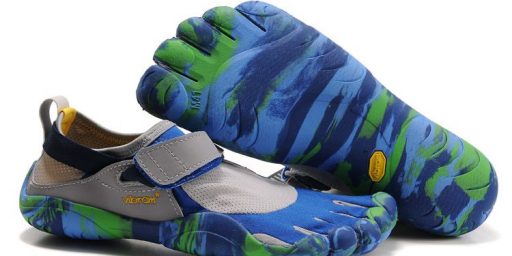Barefoot Running: Do Running Shoes Cause Injury?
Glenn Reynolds links a Popular Mechanics story on “How Barefoot Runners are Shaping the Shoe Industry.”
My initial guess was “Buying fewer shoes?” It’s a wee bit more interesting than that. Apparently, a Rick Roeber recently ran the Boston Marathon shoeless.
And a number of people—ultramarathoners, biomechanics experts and doctors included—think that’s probably the best way to run. Some go so far as to say running shoes are in fact causing injuries.
While entry into the Boston Marathon is a feat in itself—Roeber needed to have about an 8-minute-mile pace over 26 miles to qualify—attempting the race barefoot is something most runners would find an absurd, even obscene, gesture. Runners are hooked on shoes. For good reason, it would appear: Ranging from 5 mm to 22 mm thick and made mostly of polymer, running shoes are engineered to support feet for mile after mile of rough asphalt and rocky terrain. They protect vulnerable soles from glass and debris, provide padding and, shoe companies claim, help correct problematic twists and turns of our ankles and legs caused by excessive pronation.
>But to barefoot advocates such as Chris McDougall, author of Born to Run (Knopf, hitting bookstores in May), Roeber is one of the few in Monday’s race not drinking the shoe industry’s Kool-Aid. In his book, McDougall follows the Tahumara, a Mexican tribe of ultrarunners who race from 50 to 200 miles straight without shoes, yet remain healthy and injury-free. Science doesn’t support the shoe industry’s claim that “humans are born broken,” McDougall tells PM, and that running shoes exist to fix our stride. Humans have been barefoot for nearly 2 million years, but have had running shoes for only a little more than 40—when Nike-founder Bill Bowerman cobbled together the modern-day running shoe with glues, plastic and a waffle iron in his basement. Shoes cause runners to lose musculature in their feet, McDougall argues, and takes away the natural cushion in their stride.
[…]
The problem modern-day runners face, according to Hugh Herr, Popular Mechanics 2005 Breakthrough Award winner and head of the biomechatronic group at MIT, isn’t presented by our bodies but by the evolution of running surfaces. Humans that ran to scavenge or hunt for their food weren’t pounding concrete. Herr is in a unique position to weigh in on shoe technology. He defended the double-prosthetic sprinter, Oscar Pistorius, in his appeal to the International Association of Athletics Federations board last year against charges that his Cheetah prosthetics provided a mechanical advantage. Herr also invented the iWalk Powerfoot One, the most advanced robotic ankle in existence.
Bare feet just aren’t meant to support running on modern day hard-top surfaces, Herr says. In his research, Herr focused on two problems with both shod and barefoot running-pronation angle and impact force. While barefoot running is best for a natural, stress-free pronation angle, Herr says, it is not ideal for coping with roads and sidewalks that can lead to stress-impact injuries. Shoes, on the other hand, excel at diminishing the force of impact on hard ground. But they do so at the cost of the natural stride-all the padding added to the shoe exaggerates the foot’s rotation. “It’s hard to design a shoe with pronation as small as what exists naturally,” Herr says. “When you’re barefoot, you have the advantage of the heel being very thin [and thus diminishing rotation].”
Methinks the best advice for those wishing to avoid injury from miles of pounding the pavement is to grab a beer and tune in SportsCenter, instead. Of course, that may lead to other issues.






Wouldn’t you think your foot coming down on a an object (like a pebble…or Chinese star) would do more damage than a shoe could ever do???.
For the record…i’m pro footwear.
While it’s true we evolved to run on our barefeet, I think it’s a good counterpoint that the ground wasn’t covered in asphalt and cement back then.
Nike actually makes a shoe called the Free 5.0 that allows your natural motion but protects you from shards of glass and whatnot. I haven’t tried them yet, but it seems like a reasonable compromise.
I like the Vibram Five Fingers … it’s basically a rubber sock that allows you to go barefoot without cutting up your feet. Create for climbing and hiking. Horrible for bicycling 🙂
curious what the author would say to running barefoot on a treadmill. slightly harder than dirt, but presumably more forgiving than asphalt or concrete.